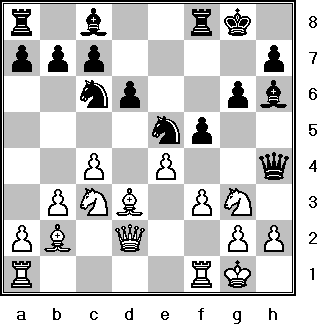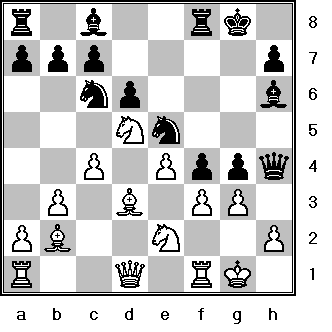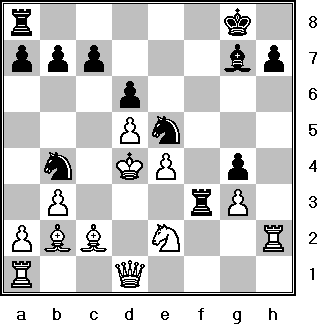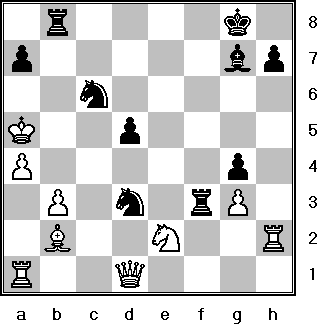-
Lev Polugaevsky - Rashid Nezhmetdinov Sochi 1958 1. d4 Nf6
2. c4 d6
3. Nc3 e5
Old Indian Defense
4. e4 exd4
5. Qxd4 Nc6
6. Qd2
This move begins an ambitious plan of developement for white. Black has given up the center in exchange for a slight intiative but if white solves all his problems, his space edge will begin to count.
6...g6
7. b3 Bg7
8. Bb2 O-O
9. Bd3
White has not decided where to castle yet.
9...Ng4
10. Nge2 Qh4
11. Ng3 Nge5

Black rejected 11...f5 because of 12. f4! and if 12...Nxh2 then 13. Nce2 and 0-0-0.
12. O-O f5 13. f3!
The beginning of a deep plan of defense. Note that 13. f4 here allows 14...Bd4+ 15. Kh1, Qxg3 16. hxg4, Qh4#
13...Bh6

14. Qd1 f4
Black plans a a piece and pawn storm on the kngside opening up the f and g files.
15. Nge2 g5
16. Nd5 g4
17. g3!

White is lost if he allows 18. h3, Bxh3 or an attack on the f file after...Kh8/...gxf3.
17...fxg3
18. hxg3 Qh3
19. f4!
Polugaevsky realized that he is safe after 19...Nf3+ 20. Kf2, Qh2+ 21. Ke3
19...Be6

A critical moment.
20. Bc2?
Here 20. Bc1 is refuted by 20...Nd4!!
But white had a better defense in 20. Bb1!, Bxd5 21. cxd5, Ne7 when GM Soltis gives 22. Kf2, Rxf4+!! 23. gxf4, N7g6 with a winning attack. However this line is not forced and white is not obliged to walk into blacks stunning sacrfice with 22. Kf2?
After over one and a half hours of thought CM 9000 considers 22. Bxe5! to be superior in the above line. eg 22...dxe5 23. Rf2, Qh5 24. Bd3, exf4 25. Nxf4, Bxf4 26. gxf4, Qh4 and considers this positon about equal. I let it examine this position over night and after 10 hours of thought gives the following line as best play: 27. Bc4, Qg3+ (or 27...g3 28. Rg2, Qf6 29. Rxg3+, Kh8 30. Qc1, Rg8 31. Kg2, Ng6 32. Qc3, Qxc3 33. Rxc3, Nxf4+ 34. Kh1, Rae8 28. Rg2, Qe3+ 29. Kh1, Ng6 30. f5, Ne5 31. d6+, Kh6 32. dxc7, g3 33. Qd6, Qxe4 34. Rf1, Rae8 35. Be6 =.
20...Rf7
21. Kf2!, Qh2+
22. Ke3 Bxd5
Eliminating a key defender, Black needs to act before white can strike back with Rh1.
23. cxd5 Nb4
24. Rh1?!

White has relied on this defense because to skewer the "h" file will win the bishop on h6 should the black queen move away with 24...Qg2. Fritz 7 considers the text (24. Rh1) to be a blunder giving it ?? and says "allows opponent counterplay."
***********************************************************************************
Perhaps better is 24. a3!? though this was reportedly refuted by Soviet analysis many years ago, but:
Fritz 7 after 9 hours of thought considers white to be at least equal after 24. a3!?. The point seems to be that the rook stays on f1 making sacks on f4 dubious and it forces the knight on b4 to make a decision:
Analysis by Fritz 7:
- = (0.03): 24...Nxc2+ 25.Qxc2 Qh3 26.Bxe5 dxe5 27.Rh1 Rxf4 28.Kd3 Rf3+ 29.Kc4 Qg2 30.Rag1 Qf2 31.Rxh6 Re3
- ± (0.72): 24...Qh3 25.axb4 Bxf4+ 26.Nxf4 Rxf4 27.Bxe5 Qxg3+ 28.Kd2 dxe5 29.Rg1 Qf2+ 30.Kc1 h5 31.Kb1
**************************************************************************************
24...Rxf4!!
In his commentary to this move, Nezhmetdinov wrote in part, "It goes without saying that it was impossible to calculate all the likely continuations over the board. The combination was intuitive and that is why it was difficult to decide on it." He had begun considering the sacrifice five moves earlier.
"What made Nezhmetdinov decide that the queen sacrifice was justified? It appears to me that all the conditions discussed above that are required for a successful king hunt are present: the white king's retreat is cut off by the black rook on the third rank; there are sufficient attacking forces in play after the queen sacrifice; and, defensive forces are in no position to stop Black's attack or to launch a counter attack."--NM Sunil Weermantry.
If now 25. Nxf4 Nxc2+ or 25. gxf4, Bxf4+ 26. Kd4 (26. Nxf4, Nxc2+ wins the queen due to mate) 26...Qf2+ 27. Kc3, Qc5#
25. Rxh2 Rf3+
26. Kd4
Black appears to have an overwhelming attack. Nevertheless, this position is difficult to judge because of the complications.
26...Bg7!

This threatens 27...b5! taking away the escape square on c4 and threatening mate on the move with 28...Nec6. 27. a4 c5+ 28. dxc6 e.p. bxc6 29. Bd3 Nexd3+ 30. Kc4 Black has succeeded in keeping the white king in the center and is playing to win.
Black could try the safer 26...c5+!? 27. dxc6ep, b5 28. Bd3 (This is given by both Soltis and Weermantry but neither analyzes any further) black best is then 28...Nexc6+! 29. Kc3, Bg7+ 30. Kd2, Rxd3+ 31. Ke1, Rxd1+ 32. Rxd1, Bxb2 33. Rxd6, Ne5 black has 3 minor pieces and a rook against 2 rooks and a knight with pawns equal, that is a slight advantage for black. Also in the current position there is no way for white to save his a-pawn, so in essence he has 2 minor pieces and a pawn against a rook with other pieces on the board. Black has an advantage in the ending but there are many technical difficulties.
27. a4
A better defensive try was 27. Ng1 but black is still winning after 27...Rxg3! as given by Soltis. CM 9000 gives the following winning line for black: 28. Ne2, Rf3 29. Ng1, c5+! 30. dxc6ep, Ned3+ 31. Kc4, b5 32. Kxb5, Rb8+ 33. Ka4, Nxb2+ 34.Ka3, Nxd1 and black is winning.
- eg.
- 35. Bxd1, Rg3! white cannot answer both ...Bxa1 and ...Nxg1 or
- 35. Nxf3, Bxa1 36. Bxd1, gxf3 37. Bxf3, Nxc6 black has won a piece, and finally '
- 35. Rxd1 which is answered by 35...Rc3! with a double attack. White is threatened with both loss of a piece (Bc2) and ...Rxc6 intending ...Ra6 mating.
27...c5+
28. dxc6 bxc6
29. Bd3 Nexd3+
30. Kc4
(Or 30. e5, Bxe5+ and 31...d5#)
30...d5+
31. exd5 cxd5+
32. Kb5 Rb8+
33. Ka5 Nc6+

White did not wait for black to choose between 34. Ka6, Nc5# or 34...Rb6#
0-1
The path that the white king takes in this game is truly fascinating.
Tactical Themes: Double attack, line opening, demolition, pin, removing a defender, discovery.
Mating Themes: Rook and Knight Mate, King in the Center, King Hunt, Linear Mate.
I consider this to be the 8th greatest attacking game of all time.